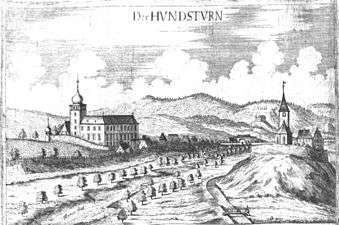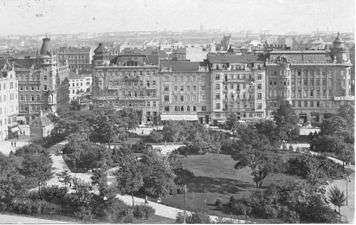Hundsturm
| Hundsturm | ||
|---|---|---|
| Suburb | ||
|
Entrance to Bruno-Kreisky-Park | ||
| ||
|
| ||
| Coordinates: 48°11′17″N 16°20′52″E / 48.18806°N 16.34778°ECoordinates: 48°11′17″N 16°20′52″E / 48.18806°N 16.34778°E | ||
Hundsturm was an independent municipality (Gemeinde) of Austria until 1850 and is today a suburb of Vienna, in the 5th District of Vienna, Margareten.
In 1632, the first documented mention of Hundsturm was made. In 1600, Archduke Matthias, who later became Emperor, built a Rüdenhausen in Hundsturm. The name Hundsturm ("Hounds Tower") might come from this Rüdenhausen. It is more likely, however, that the name goes back to the former mill, which was occupied in 1408 as the first time in the disk Hunczmühle Ried.
The Rüdenhausen was demolished in 1672, when Hundsturm Castle was built in its place, but in the 19th Century, the castle was also demolished. During the 17th Century, the settlement grew around the castle, especially along the present Schönbrunnerstraße between Spengergasse and Margaretengürtel. In 1842 Hundsturm came through the purchase of the municipality to Vienna. The incorporation took place in 1850 as part of the original configuration of the 4th District Wieden. However, in 1862, Hundsturm was allocated to the new 5th District Margareten. In 1907, smaller parts of the former suburb were re-zoned into the 12th District Meidling.
At the Hundsturm cemetery, founded in 1783, was buried in 1809, the famous Austrian composer Joseph Haydn. Today the remains are instead in the Haydn Park Cemetery within Meidling.
The Hundsturm coat of arms shows, on a blue background, a castle tower on a green meadow. From the open door of the golden tower jumps a dog.
Gallery
- Old Scenes of Hundsturm
 Hundsturm circa 1773
Hundsturm circa 1773 Hundsturm circa 1830
Hundsturm circa 1830 Hundsturm Castle from the west
Hundsturm Castle from the west Bruno-Kreisky-Park in World War II
Bruno-Kreisky-Park in World War II
External links
- Bezirksmuseum Margareten - Hundsturm (German)

